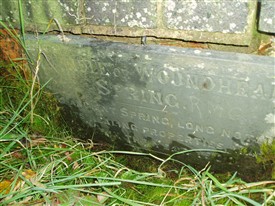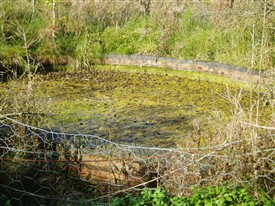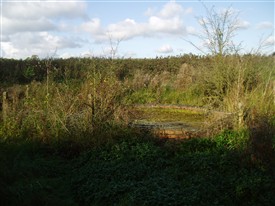The Woundheal Spring

The tablet
RBParish

The well basin
RBParish

Distance view of the well
RBParish
The spring lies in a field to the south-east, I have not marked it exactly as it is on private property
A little known healing spring
By R B Parish
In a remote field location, far away from any footpath, in this border village, is the little known or known about, Woundheal or Oundle Spring. Why this spring should be favoured is unclear, especially as there are more convenient springs, so something in its properties suggested its’ importance. Indeed, a tablet affixed to the wall of the spring’s enclosure and close to the spring’s outflow which reads:
“Oundle or Woundheal Spring. This ancient spring, long noted for its healing properties. Repaired in the year 1900”
In particular, its water was thought to be good for skin diseases such as eczema and scrofula. Perhaps its noted properties meant that despite being remote to have been considered worth visiting. Today no one appears to visit being enclosed on private land, owned it happens now by landowners who have actively discouraged visitors I was informed. Interestingly, its most recent frequenters, as Morrell (1988) notes, were until recently, two brothers who would swim naked in it each morning. They would not want to do so now as its waters have a decidedly green coating of blanket weed I would think.
Morrell (1988) describes the spring as filling a large circular stone bath, a structure surrounded by a low wall where a carved tablet reads:
“Men may come, men may go, but I go on forever."
However, whether the bath itself has overflowed or Morrell is mistaken is unclear, as a visit in the 1990s showed the low wall to enclose the whole of the spring with neither sign of a separate bath nor the carved tablet as noted above? It is possible that the rebuilding of the springhead lost this original tablet. The present structure, six foot by six foot and semi circular in shape, is in fair condition being no older than its 1900 fabric perhaps, with a few black coping bricks missing but no substantial damage to the red brick walling. The site remains, one of the most substantial healing wells in the county and hopefully one of which more details could be discovered and perhaps one day greater access.
Extracted from R.B. Parish (2008) Holy wells and healing springs of Nottinghamshire. See books for sale.
References:
Morrell, R., (1988) Nottinghamshire Holy wells